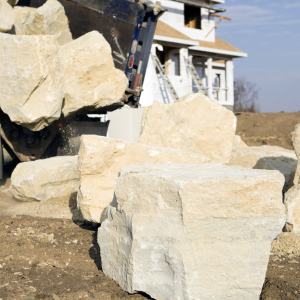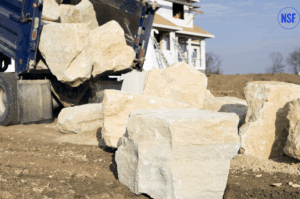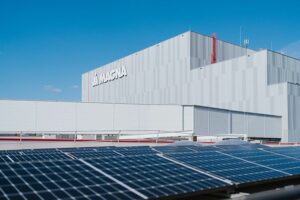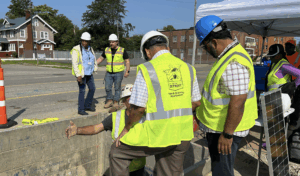
- Kim Kisner
- Business
- 02/25/2025
The Role of Adaptive Reuse in Architecture

Quinn Evans is a nationally recognized architecture and design firm specializing in historic preservation, adaptive reuse, and sustainable building strategies.
With a strong commitment to reducing environmental impact, the firm prioritizes decarbonization through the reuse of existing structures, energy-efficient design, and innovative material solutions. An example of this is the firm’s leadership in restoring Detroit’s historic Michigan Central Station. In collaboration with Ford Motor Co., Quinn Evans assembled a multidisciplinary team of architects, engineers, historians, and conservation specialists to rehabilitate the long-abandoned landmark.
SBN Detroit interviewed Senior Associate Angela Wyrembelski to explore the challenges and opportunities of decarbonizing buildings, the role of adaptive reuse in reducing embodied carbon, and the latest tools and technologies shaping the future of sustainable architecture.

Q: Walk us through how Quinn Evans approaches decarbonization in building design and renovation.
A: At the core of our approach is valuing what already exists. Reusing and adapting existing structures is our first line of defense against excessive carbon emissions. New construction comes with an enormous carbon cost, from material extraction to manufacturing and transportation. By preserving and repurposing buildings, we significantly reduce that impact while maintaining the historical and cultural integrity of structures that communities value.
Beyond preservation, we focus on making buildings high-performing through energy-efficient systems and renewable energy integration. We also consider material selection – prioritizing low-carbon materials and renewable resources – to minimize environmental impact.
These layers work together to create buildings that are both sustainable and adaptable for the future.
Q: What are the most significant contributors to carbon emissions in architecture and development?
A: The structure itself is by far the biggest contributor. Building materials such as steel and concrete account for nearly 50% of a structure’s carbon footprint. Concrete, in particular, is incredibly carbon-intensive.
Q: What strategies can be implemented to counteract these carbon contributors?
A: We prioritize material selection. Low-carbon concrete is gaining traction… there are manufacturers working with different mixes that are much better for the environment.
We also advocate for retaining as much of a structure as possible to minimize the need for new materials.
Additionally, we use Environmental Product Declarations (EPDs) to ensure transparency in material selection and work closely with manufacturers that provide sustainable options. It’s a holistic approach that combines design, technology, and materials to drive lower carbon outcomes.
Q: What are the biggest challenges in designing and executing low-carbon projects?
A: One of the biggest challenges is cost perception. Energy-efficient upgrades are often easier to justify because they lead to lower utility bills. However, the financial return on low-carbon materials isn’t always as direct. Convincing clients to invest in sustainable materials that may have a higher upfront cost but a longer-term environmental benefit can be difficult.
Q: How does adaptive reuse contribute to sustainability?
A: Adaptive reuse is one of the most impactful sustainability strategies. Embodied carbon in new buildings can be equivalent to operating a building for 10 to 50 years. The construction phase—material extraction, manufacturing, transportation, and installation—is highly energy-intensive.
By contrast, when we reuse a structure, much of the material is already on-site, eliminating those initial carbon expenditures. This is why we advocate for renovation and repurposing over demolition and new construction whenever possible.
How does your work in Detroit compare to other markets in terms of sustainable development?
A: Michigan lags behind some coastal states in energy codes and sustainable requirements. Cities on the East Coast, for example, have stringent energy mandates that compel developers to meet higher efficiency standards. In Michigan, we often have to educate clients on the benefits of going beyond minimum code requirements.
That said, there is a strong culture of stewardship in Michigan. Legacy institutions within the auto industry, churches, and universities have deep-rooted histories, and many of these organizations recognize the value of long-term sustainability. Our role is to help them integrate sustainability into their projects in ways that align with their mission and values.
Q: Quinn Evans played a major role in the Michigan Central revitalization. What sustainable strategies were implemented, and what lessons can be applied to future renovations?
A: This was an incredibly rewarding project. The first step was assessing what could be saved. The building had been abandoned for over 30 years, yet it still had incredible architectural details that we wanted to preserve. We focused on retaining as much of the original materials as possible, aligning with the embodied carbon narrative.
Another key aspect was optimizing the building’s performance and envelope. We used advanced modeling software to analyze thermal performance, airflow, and ventilation. This helped us right-size insulation and mechanical systems to enhance efficiency while preserving historic integrity.
For example, our studies showed that adding insulation to the upper brick portion of the building would improve performance, but doing the same to the limestone base would trap moisture and accelerate deterioration. These findings guided our approach, ensuring sustainability without compromising the building’s long-term health.
Q: What new digital tools are helping architects track and optimize carbon savings?
A: We use a variety of tools, including Tally and EC3, to analyze material selections and their carbon impact. For whole-building carbon analysis, we use C-Scale (EPIC) and the CARE Tool, which help compare carbon emissions from new versus renovated buildings. These technologies allow us to make data-driven decisions that prioritize sustainability from the outset.

Q: What are some of the most promising sustainable materials currently being developed?
A: There’s been significant progress in repurposing waste materials. We’re seeing recycled glass being used in place of gravel and construction waste being reintegrated into new builds.
At Michigan Central, historic materials that were unable to be reinstalled were reused in creative ways. Stone cladding from the station’s columns was repurposed within the counters of the café, and marble was incorporated into the landscape as accent features. Finding innovative ways to repurpose materials keeps them out of landfills and adds unique character to a project.
Q: Looking ahead, where do you see sustainable architecture evolving in the next five to ten years?
A: There is a growing shift toward prioritizing carbon reduction rather than energy efficiency alone. While energy performance remains important, the industry is increasingly focusing on reducing carbon emissions through smarter material choices and more efficient supply chains.
We also anticipate greater emphasis on adaptability and resilience. The best way to ensure a building remains sustainable is to design it for longevity and flexibility. If a structure can be easily adapted for different uses over time, it reduces the likelihood of demolition. The goal is to create buildings that are built to last, minimizing environmental impact across their entire lifecycle.
Be sure to subscribe to our newsletter for regular updates on sustainable business practices in and around Detroit.
Kim Kisner
- All
- Business
- Community
- Education
- Events

Farmington Hills-based Modal Motors designs and manufactures next-generation electric motors engineered for high torque density, simplified assembly, and scalability in the United States. The company’s transverse-flux architecture reduces reliance on rare-earth materials while improving efficiency and performance across mobility applications, including EVs, drones, and industrial equipment. By rethinking both motor design and manufacturability, Modal Motors aims to strengthen domestic supply chains and support the growing electrification industry. The...

Revolin Sports, a Holland, Michigan-based startup founded by siblings Hugh and Greta Davis, is aiming to change how sports equipment is made — starting with the fastest-growing sport in America: pickleball. The company is using renewable materials, energy-efficient manufacturing, and recyclable design to lower the environmental footprint of high-performance paddles. SBN Detroit interviewed Hugh Davis, cofounder of Revolin Sports, about how sustainable materials, circular manufacturing, and local partnerships...

Ann Arbor-based NSF is a 501(c)(3) nonprofit that develops public health standards and provides auditing, certification, and training across industries ranging from food and water to consumer products and manufacturing. Its work often intersects with sustainability, helping businesses measure environmental performance and verify progress toward their goals. SBN Detroit interviewed Justin Brown, senior manager of sustainability & product verification at NSF, about the challenges companies face in advancing...







